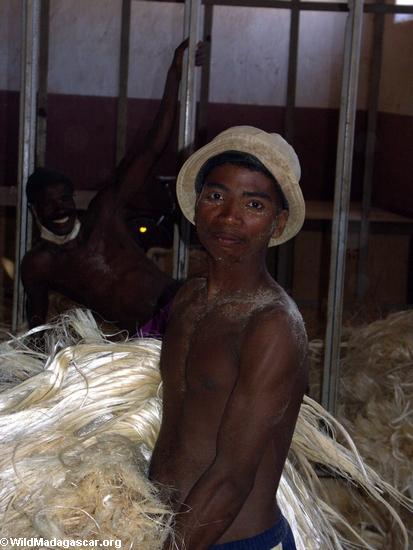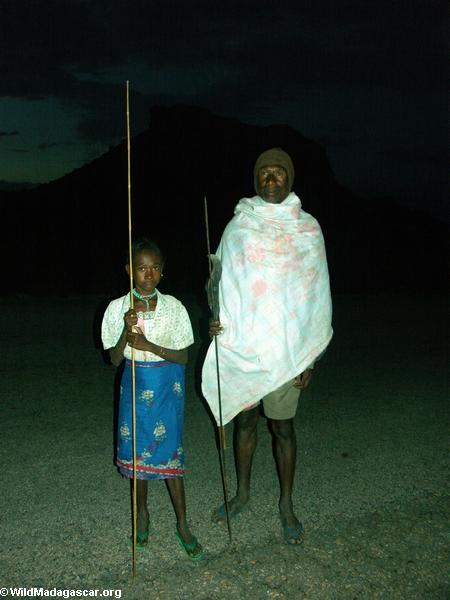Studies prove people of Madagascar came from Borneo and Africa
mongabay.com
July 8, 2005
Studies released earlier this year found the people of Madagascar have origins in Borneo and East Africa.
Half of the genetic lineages of human inhabitants of Madagascar come from 4500 miles away in Borneo, while the other half derive from East Africa, according to a study published in May by a UK team.
The island of Madagascar, the largest in the Indian Ocean, lies some 250 miles (400 km) from Africa and 4000 miles (6400 km) from Indonesia. Its isolation means that most of its mammals, half of its birds, and most of its plants exist nowhere else on earth. The new findings, published in the American Journal of Human Genetics, show that the human inhabitants of Madagascar are similarly unique – amazingly, half of their genetic lineages derive from settlers from the region of Borneo, with the other half from East Africa. Archaeological evidence suggests that this settlement was as recent as 1500 years ago – about the time the Saxons invaded Britain.
“The origins of the language spoken in Madagascar, Malagasy, suggested Indonesian connections, because its closest relative is the Maanyan language, spoken in southern Borneo,” said Dr Matthew Hurles, of the Wellcome Trust Sanger Institute. “For the first time, we have been able to assign every genetic lineage in the Malagasy population to a likely geographic origin with a high degree of confidence.”
“Malagasy peoples are a roughly 50:50 mix of two ancestral groups: Indonesians and East Africans. It is important to realise that these lineages have intermingled over intervening centuries since settlement, so modern Malagasy have ancestry in both Indonesia and Africa.”
The team, from Cambridge, Oxford and Leicester, used two types of DNA marker to study DNA diversity: Y chromosomes, inherited only through males, and mitochondrial DNA, inherited only through females. They tested how similar the Malagasy were to populations around the Indian Ocean. The set of non-African Y chromosomes found in the Malagasy was much more similar to the set of lineages found in Borneo than in any other population, which demonstrates striking agreement between the genetic and linguistic evidence. Similarly, a ‘Centre of Gravity’ was estimated for every mitochondrial DNA to suggest a likely geographical origin for each. This entails calculating a geographical average of the locations of the best matches within a large database of mitochondrial lineages from around the world.
“The Centres of Gravity fell in the islands of southeast Asia or in sub-Saharan Africa,” explained Dr Peter Forster, from the McDonald Institute for Archaeological Research, University of Cambridge, one of the co-authors. “The evidence from these two independent bits of DNA supports the linguistic evidence in suggesting that a migrating population made their way 4500 miles across the Indian Ocean from Borneo.”
 Young Malagasy sisal worker |
The striking mix suggests that there was substantial migration of people from southeast Asia about 2000-1500 years ago – a mirror image of the migrations from that region into the Pacific, to Micronesia and Polynesia, that had occurred about 1000 years earlier. However, unlike the privations suffered by those eastward travellers, the data suggests the early Malagasy population survived the voyage well, because more genetic variation is found in them than is found in the islands of Polynesia. ‘Bottlenecks’ in evolutionary history, where the population is dramatically reduced in number, are a common cause of reduced genetic variation.
Even though the Africa coast is only one-twentieth of the distance to Indonesia, it appears that migrations from Africa may have been more limited, as less of the diversity seen in the source population has survived in Madagascar.
But why, if the population is a 50:50 mix, is the language almost exclusively derived from Indonesia?
“It is a very interesting question, for which we have as yet no certain answer, as to how the African contribution to Malagasy culture, evident in biology and in aspects of economic and material culture, was so largely erased in the realm of language,” commented Professor Robert Dewar, of The McDonald Institute for Archaeological Research, University of Cambridge. “This research highlights the differing, and complementary, contributions of biology and linguistics to the understanding of prehistory.”
The population structure in Madagascar is a fascinating snapshot of human history and a testament to the remarkable abilities of early populations to undertake migrations across vast reaches of ocean. It may also be important today for cutting edge medical science.
“There has recently been dramatic progress in the development of experimental and statistical methods appropriate for gene mapping in admixed populations,” said David Goldstein, Wolfson Professor of Genetics, University College London. “To succeed, however, these methods depend on populations with well defined historical admixtures. This work shows provides compelling evidence that the Malagasy are such a population, and again shows the value of careful study of human population structure.”
Our human history is a rich mix of peoples and their movement, of success and failure. Madagascar holds an enriching tale of the ability of humans to survive and to reach new lands.
This release originally appear at Human inhabitants of Madagascar are genetically unique
Centers Participating in the study:
- Wellcome Trust Sanger Institute – Wellcome Trust Genome Campus, Hinxton, UK
- McDonald Institute for Archaeological Research – University of Cambridge, Cambridge, UK
- Weatherall Institute for Molecular Medicine – University of Oxford, Oxford, UK
- Department of Genetics – University of Leicester, Leicester, UK
Publication details
-
The dual origin of the malagasy in island southeast Asia and East Africa: evidence from maternal and paternal lineages.
Hurles ME, Sykes BC, Jobling MA, Forster P
Am J Hum Genet. 2005;76;894-901. PMID: 15793703
People of Madagascar have origins in Borneo, Africa
New study confirms unusual ancestry of the Malagasy
Sailing across the Indian Ocean to make landfall on the world’s fourth largest island?
Rhett Butler, mongabay.com
May 3, 2005
A new study in the American Journal of Human Genetics confirms that the people of Madagascar have origins in both East Africa and also distant Borneo.
Despite the island’s proximity to southern Africa, some anthropologists believe it was ethnic Indonesians who first settled Madagascar 1500-2000 years ago. The language of Madagascar, called Malagasy, can be traced back to Indonesia where it most closely resembles the modern Malayo-Polynesian language of Ma’anyan, which is spoken by people in the Barito Valley of southern Borneo. Some anthropologists postulate that these Indonesians could have either sailed directly across the Indian ocean — possible given the sailing prowess of these people — or gradually made their way along the coast of South Asia eventually finding their way to the island, which is the fourth largest in the world. On the way, these intrepid explorers could have mixed with mainland Africans or Africans may have arrived at a later date.
Regardless of who set foot first on the island, most experts agree that Madagascar’s inhabitants arrived relatively recently. There is no evidence of a stone age in Madagascar and the island was settled around the time Polynesians reached the planet’s most isolated place — Easter Island. It is thought that subsequent migrations have brought other groups (Arabs and Indians) into the ethnic and cultural mix.
The study
The study, led by a team of geneticists at the universities of Cambridge, Oxford and Leicester examined both the Y chromosomes of Madagascar residents — inherited essentially unchanged from father to son — and the mitochondrial DNA, which is passed directly from mothers to their children. Tiny mutations in these two forms of DNA can help scientists trace human migration and inheritance.
 A father and daughter from the Bara group in Madagascar. |
The researchers found that as a whole, Malagasy people (both the name of the language and the people of Madagascar) are a roughly 50:50 mix of two ancestral groups: Indonesians and East Africans. Today, this mixed origin has produced an interesting set of cultures that draws from southeast Asia, India, Africa, and the Middle East.
Diverse society
Within Madagascar there is a great deal of variation between ethnic groups from the Indonesian-looking Merina in the highlands to Arabic Antaimoro on the eastern coast to the African Sakalava in the south and west of the country. Despite these differences, the Malagasy language is spoken throughout the country, something which is a bit surprising given the size and ethnic diversity of the island. Sharing a common language is the strongest bond between Malagasy — people’s physical appearance, religious practices, and traditions are highly regional.
Malagasy language
Malagasy only recently become a written language. Until Welsh missionaries transcribed the language in the 1820s, the Malagasy had to rely on oral history to mark past events. However, even with the development of a written form, written Malagasy hardly resembles spoken Malagasy — the last syllable is typically dropped while unstressed syllables in the middle of words often disappear (spelling versus pronunciation was evidently influenced by the Welsh transcribers). The capital city of Antananarivo is pronounced “Tananarive” but usually shortened to “Tana.”
Cultural richness
What this all means is the people of Madagascar have a remarkable ancestry. One that has produced a unique set of customs and extraordinary cultural richness. Madagascar is a place where ancestors are as much a part of the present day as they are of the past; where in many areas taboo and tradition takes precedence over the law; and western-style religion is freely mixed with beliefs in sorcery and unparalleled funerary customs.
This article used information from WildMadagascar.org, Reuters, and the American Journal of Human Genetics. For further reading on the people of Madagascar I highly recommend The Eighth Continent by Peter Tyson.
For more on Madagascar, take a look at WildMadagascar.org.